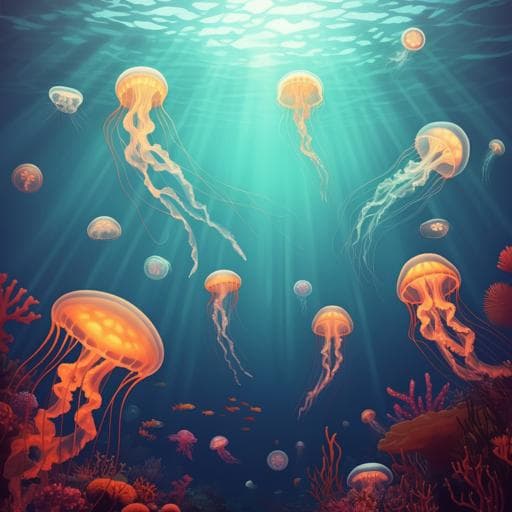
Environmental Studies and Forestry
Climate-driven zooplankton shifts cause large-scale declines in food quality for fish
R. F. Heneghan, J. D. Everett, et al.
This groundbreaking study by Ryan F. Heneghan, Jason D. Everett, Julia L. Blanchard, Patrick Sykes, and Anthony J. Richardson reveals how climate change is reshaping zooplankton communities and what this means for marine food webs. Discover how future oceans will favor certain zooplankton types and the consequences for fish species in tropical regions as we approach 2100.
~3 min • Beginner • English
Introduction
The study investigates how climate change will alter global zooplankton community composition and the consequences for marine food webs, particularly small pelagic fish (SPF) that link plankton to higher trophic levels. Zooplankton are highly diverse and crucial for energy transfer from phytoplankton to fish, yet are often poorly resolved in ecosystem models. Functional traits such as predator–prey mass ratios (PPMRs) and carbon content determine both zooplankton fitness and the efficiency and quality of energy transfer to higher trophic levels. The authors hypothesize that climate-driven changes in phytoplankton biomass and size structure will restructure zooplankton communities toward carnivores and gelatinous filter feeders, lengthening food chains and reducing diet quality for fish, thereby diminishing fish carrying capacity, especially in warmer, oligotrophic regions.
Literature Review
Prior work highlights the central role of zooplankton in biogeochemical cycles and fisheries and emphasizes trait-based approaches to understand community composition and energy transfer. Many ecosystem models historically under-resolve zooplankton, potentially missing key climate-driven food-web changes. Empirical and modeling studies show large-scale links between phytoplankton and zooplankton biomass and suggest future dominance of smaller phytoplankton with warming. PPMR influences trophic steps and energy transfer efficiency; filter feeders with huge PPMRs (e.g., salps, larvaceans) can directly channel energy from small phytoplankton, whereas carnivorous copepods (low PPMR) imply longer chains. Zooplankton taxonomic groups differ markedly in carbon content, affecting prey quality for fish. Observations in some regions already indicate shifts from krill/omnivores toward salps/gelatinous taxa under warming and declining productivity, with implications for predator diets and condition (e.g., Northeast Pacific heatwave ‘Blob’).
Methodology
The authors use the Zooplankton Model of Size Spectra (ZooMSS v2.1), a global trait-based, size-spectrum ecosystem model resolving: a single phytoplankton community; microzooplankton (heterotrophic flagellates and ciliates); seven meso- and macrozooplankton groups (omnivorous copepods, carnivorous copepods, larvaceans, salps, euphausiids, chaetognaths, jellyfish); and three size-based fish groups (small pelagic ≤100 g, medium pelagic 100 g–10 kg, large pelagic 10 kg–1 t). Zooplankton groups are defined by size ranges, feeding traits (PPMR, feeding kernel width), and carbon content; fish share common functional traits aside from asymptotic size. For analysis, meso- and macrozooplankton are aggregated into three functional feeding groups: omnivores (omnivorous copepods, euphausiids), carnivores (carnivorous copepods, chaetognaths, jellyfish), and filter feeders (larvaceans, salps). ZooMSS growth is driven by prey availability within preferred size ranges; conversion efficiency depends on prey carbon content. Mortality includes predation and senescence (non-predation mortality increases with temperature). Temperature and phytoplankton variables force the model on a 1° grid with annual means. A uniform Q10=2 modulates growth and mortality with temperature. Phytoplankton size structure is derived either from surface chlorophyll a via the Brewin et al. algorithm (estimating pico-, nano-, microphytoplankton fractions and converting to carbon) or, where available, from size-fractionated, depth-resolved phytoplankton carbon (GFDL-ESM4). Continuous phytoplankton size spectra (slope, intercept, max size) are computed per grid cell and year. Forcing: five CMIP6 Earth-system models (CESM2, GFDL-ESM4, IPSL-CM6A-LR, MPI-ESM1-2-HR, UKESM1-0-LL) under historical (1980–2014) and three SSP scenarios (2015–2100: SSP1-2.6, SSP3-7.0, SSP5-8.5). Simulations: run 1,000 years per grid cell (half-weekly timestep; size classes in 0.1 log10 bins), with 500-year burn-in; outputs are long-term means over the final 500 years to average cyclic dynamics arising from large PPMRs. Analyses exclude the coastal Longhurst biome due to high uncertainty in coarse-resolution ESMs; results summarized for polar, temperate (westerlies), and tropical (trades) Longhurst biomes. SPF trophic level is computed iteratively (Gauss–Jacobi) from diet composition and prey trophic levels; SPF diet carbon content is the consumption-weighted prey carbon percentage. Statistics: ensemble means and standard deviations across the five ESM-forced runs; significance of biomass changes assessed via two-sided Mann–Whitney U-tests comparing 1980–2000 vs 2080–2100 (n=100 each). A sensitivity experiment fixed all zooplankton carbon contents at 10% to test the role of declining prey carbon on SPF biomass (trophic amplification). Code and data are openly available (GitHub; Zenodo).
Key Findings
- Global declines in zooplankton biomass: total zooplankton decreases by 7±3% (SSP1-2.6), 12±5% (SSP3-7.0), and 16±4% (SSP5-8.5) by 2080–2100 relative to 1980–2000 (P ≤ 0.001). Primary driver is reduced phytoplankton biomass; warming is secondary via increased senescence mortality.
- Functional group responses (global, 2080–2100 vs 1980–2000):
- Omnivores: −8±4% (SSP1-2.6), −14±5% (SSP3-7.0), −18±4% (SSP5-8.5), largest declines (P ≤ 0.001).
- Filter feeders: −1±2% (SSP1-2.6), −5±4% (SSP3-7.0), −6±5% (SSP5-8.5), modest declines (P ≤ 0.001).
- Carnivores: −1±2% (SSP1-2.6), −2±5% (SSP3-7.0), −2±6% (SSP5-8.5), small declines (significant in lower scenarios).
- Biome heterogeneity (SSP5-8.5):
- Tropical: total zooplankton −27±10%; omnivores −34±11%; filter feeders −8±8%; carnivores −2±10%.
- Temperate: total −11±5%; omnivores −12±5%; filter feeders −5±3%; carnivores −2±3%.
- Polar: total −8±11%; omnivores −8±13%; filter feeders ~0±2%; carnivores −4±5%.
- Community composition shifts: increasing dominance of carnivores and gelatinous filter feeders in expanding oligotrophic gyres; omnivores decline widely. Within groups, salps, carnivorous copepods, and chaetognaths tend to increase proportionally, while larvaceans and jellyfish show regional declines due to predator-prey interactions.
- SPF diet and trophic level (SSP5-8.5):
- Diet composition shifts 1980→2100 (global): omnivores 79%→72%; filter feeders 13%→16%; carnivores 8%→12%.
- Mean SPF trophic level rises slightly: globally 3.67→3.74; tropical 3.76→3.86 (small increases despite more carnivores, due to buffering by filter feeders with very large PPMRs providing a direct pathway from small phytoplankton).
- Declining diet quality: gelatinous zooplankton are 65–95% less carbon-dense than omnivores. SPF diet carbon declines by ~3.5% globally (from just over 9% to 8.7%) and ~4.5% in the tropics.
- Fish biomass impacts: SPF biomass declines ~20% globally (1980→2100) under SSP5-8.5, with −10% to −35% across biomes. Trophic amplification observed where SPF biomass declines exceed phytoplankton declines.
- Sensitivity to prey carbon content: Holding zooplankton carbon content constant reduces tropical SPF biomass declines by ~10% (to ~32% vs ~35%), indicating increasingly gelatinous, low-carbon prey exacerbate fish biomass losses in the tropics; minimal effect in temperate regions; slightly larger declines in polar waters under constant-carbon assumption.
- Drivers: Shifts primarily follow phytoplankton size-structure changes (increasing picophytoplankton fraction), favoring filter feeders and carnivore pathways; warming per se affects all groups similarly and is secondary in composition changes.
Discussion
Findings support that reduced primary production lowers fish biomass but challenge the expectation of substantially longer food chains under climate change. Although carnivores increase and omnivores decrease, the rise of gelatinous filter feeders, with extremely high PPMRs, partially preserves a shorter effective pathway from small phytoplankton to fish, limiting increases in SPF trophic level. However, this buffering comes with reduced prey carbon content and thus lower diet quality for fish, particularly in the tropics, contributing to trophic amplification of biomass declines. Observational evidence (e.g., the 2013–2016 North Pacific heatwave) corroborates modeled shifts toward gelatinous prey and associated declines in fish condition. Spatial uncertainty exists, notably in the Southern Ocean where phytoplankton responses are poorly constrained. Overall, climate change is projected to restructure zooplankton communities toward more gelatinous and carnivorous dominance, diminishing the carbon quality of food available to SPF and exacerbating biomass reductions in low-latitude systems.
Conclusion
This work provides a global, trait-based assessment linking climate-driven phytoplankton shifts to zooplankton community restructuring and downstream effects on fish diet, trophic level, and biomass. Key contributions are: (1) quantification of global declines in zooplankton and SPF biomass driven by reduced phytoplankton; (2) identification of a widespread shift from omnivores toward carnivores and gelatinous filter feeders; (3) demonstration that gelatinous filter feeders can buffer increases in food-chain length while lowering prey carbon quality; and (4) evidence that declining prey carbon content slightly amplifies tropical fish biomass losses. Future research should: incorporate temperature-specific physiological responses for different gelatinous and crustacean taxa; include two-way trophic coupling with phytoplankton; resolve reproductive strategies, seasonality, and phenological mismatches; add hydrodynamics and movement; consider adaptation and plasticity in functional traits; and integrate fishing and regional downscaling to better capture coastal and upwelling dynamics.
Limitations
- Model simplifications: annual forcing and fixed recruitment omit explicit reproduction dynamics, seasonality, and phenology, potentially underestimating climate impacts at fine scales (e.g., trophic mismatches).
- Functional traits fixed: no adaptive responses or plasticity under changing conditions.
- Unidirectional coupling: phytoplankton treated as an external resource without explicit predation feedbacks from consumers.
- Uniform temperature dependence: a single Q10 applied across groups, not capturing taxon-specific sensitivities.
- Lack of hydrodynamics: no passive/active movement, vertical mixing, or migration, which may bias regional abundances.
- Phytoplankton representation: reliance on surface chlorophyll a for most ESMs misses deep chlorophyll maxima and vertical size-structure; CESM2 size-fractionated outputs unusable due to inconsistencies.
- Spatial scope: coastal biome excluded; ESM coarse resolution limits coastal/upwelling fidelity; notable uncertainty in Southern Ocean phytoplankton responses.
- Potential underestimation of gelatinous roles: temperature-only effects on gelatinous groups and ease of capture/digestion by fish not fully represented; fishing impacts on jellyfish competitors/predators not modeled.
Related Publications
Explore these studies to deepen your understanding of the subject.







